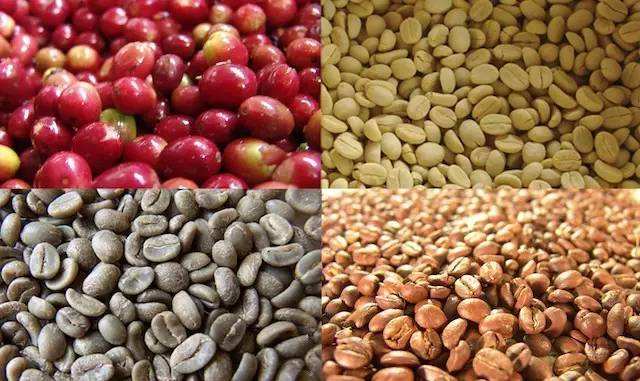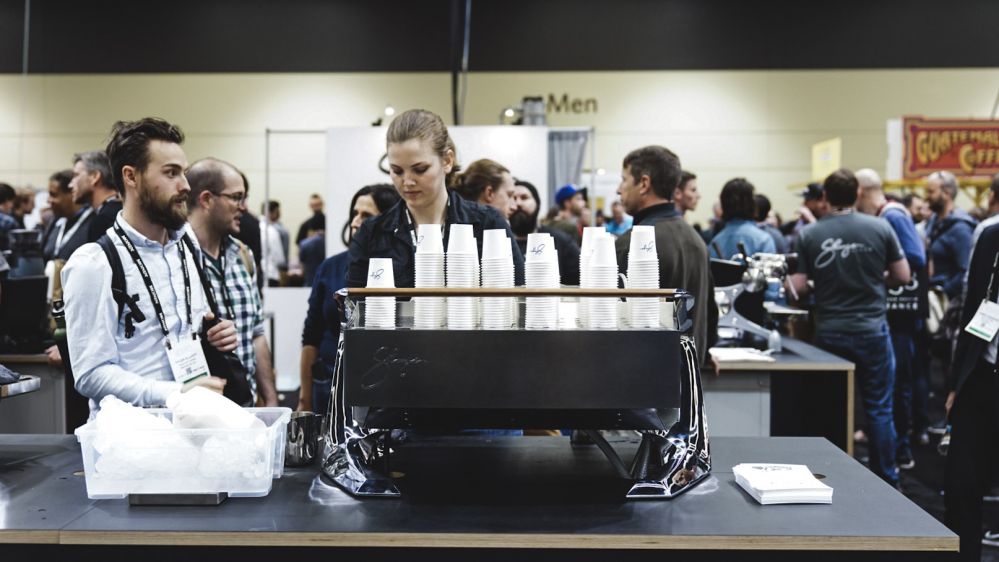Why does coffee need to be processed? Introduction to the difference in the process of washing coffee beans and drying honey
Follow the caf é (Wechat official account vdailycom) and found that Beautiful Cafe opened a small shop of its own.
Before understanding the method of treatment, there is a knowledge that must be popularized to non-coffee enthusiasts: "what is coffee?"
one
Coffee fruit
Coffee tree is a shrub or small tree of Rubiaceae. It blossoms for the first time about three years old. The white flowers give off a faint fragrance of jasmine and begin to bear fruit a few months later.
The fruit is green at first, then gradually turns yellow, turns red when ripe, and is very similar to cherries, so it is called cherry coffee (Coffee Cherry), which can be harvested at this time.
Ripe coffee berries look like cherries, are bright red and contain a pair of seeds, namely coffee beans (Coffee Beans).
The two beans are connected face to face with each other on one side of the plane. Each coffee bean has a thin outer film, which is called silver skin, and its outer layer is covered with a yellow outer skin, called endocarp. The whole coffee bean is wrapped in a sticky pulp to form the coffee pulp, which is soft and sweet, with the outer shell.
two
Common treatment method
So coffee is not just beans. But why introduce the coffee fruit before talking about the treatment?
First, when coffee farmers pick them, they look like this, not the coffee beans we see now that are processed and roasted. All we need is coffee seeds, so the treatment can remove the skin and flesh and leave the seeds.
Second, at this time is still the fruit of coffee fruit, the water content is quite high, and coffee pulp contains sugar, improper storage can easily lead to fermentation, mildew, and even deterioration. Therefore, people have to find ways to turn coffee fruits into substances that are easy to store and transport.
Sun treatment Natural Process
Sun drying is the most common way to treat coffee, through drying the coffee fruit, and then peeling off the pulp and peel. Tanning has the longest history of all coffee treatments. a considerable amount of coffee in the world is treated by solarization, which is generally used in countries with lack of water, less rainfall and more sunshine.

Technics
1. Screening
Put the picked coffee cherries in the pool, the ripe fruit will precipitate to the bottom of the pool, and the unripe fruit will float on the water. Coffee farmers need to screen out the immature fruit first.
two。 Dry in the sun
The selected fruits will be laid directly on the ground or on the net bed to dry, depending on the local climatic conditions, it will take about 2-4 weeks, and someone has to turn it regularly in the process. When the moisture reaches about 12%, the sun-dried coffee fruit can be stored.
3. Peeling
After the coffee fruit is dried, the outer skin will easily come off, and the local coffee farmers will use a special sun shelling machine to peel off the skin and leave the coffee seeds we need. After manual selection and classification, it is exported to all over the world.
Flavor
The color of the raw beans in the sun is yellow, and the pulp and raw beans are retained in the process of treatment. the fermentation of the pulp can give coffee beans fruit, floral and fermented wine flavor, strong sweetness, thick taste and complex aroma, but it may also produce some miscellaneous smell at the same time.
"Red treatment, ruby treatment"
The "red treatment" and "ruby treatment" of 90 + use the sun method, but there are more stringent criteria in the process of selecting coffee fruits.
Red treatment Red
The so-called "red treatment" is a special treatment carried out by the 90+ team through their own patented drying technology, which makes the color of shelled coffee beans show varying degrees of red, from light red to ruby red. This treatment will once again enhance the aromatic characteristics of the coffee itself, and will reflect a strong sweetness with obvious fruit flavor on the palate.
Ruby treated Ruby
The so-called "ruby" treatment is also a more difficult and extreme way of dealing with red. So that the red treatment of sweetness and fruit to the extreme, accidentally more than it will become a bad fermentation flavor, this method also requires a lot of manual screening. Every raw bean must meet the "ruby" standard in order to be called a "ruby" bean. It has been eliminated many times, tried many times, and only the last point can meet the standard of "ruby", so it is expensive.
Washing treatment method Washed
Because there was no sufficient sunshine in the West Indies, the Dutch introduced the Water washing Act around 1740. In the washing process, the pulp of the coffee fruit is first removed, then the residual mucous membrane on the inner pericarp is removed by a fermentation tank, and the beans are washed and dried.
Technics
1. Screening
Like the sun treatment, washing also requires the removal of low-density unripe beans, which are also soaked in a pool and precipitated to pick out the unripe beans.
two。 Remove the pulp
Use a special machine to remove the peel and pulp, leaving only the coffee beans wrapped in the endocarp, but at this time, there is still a small layer of mucous membrane on the raw coffee shell.
3. Remove pectin
At this time, there is still colloid on the surface of coffee beans, and we need to remove it. This mucous membrane has strong adhesion and is not easy to remove. It must be placed in the tank for about 18-36 hours to ferment and decompose the mucous membrane.
4. Water washing
The fermented coffee is washed in a flow tank to remove the attached pulp and pectin. In order to create a new flavor, some producers will soak and ferment the washed coffee in a clear pool again to produce a more special sour flavor.
5. Drying
At this time, the water content of washed coffee beans is so high that in order to prevent further fermentation from becoming rotten, we need to dry for about 1-3 weeks, and sometimes with the help of a dryer. When the water content reaches about 12%, the coffee can be stored in the warehouse.
6. Shelling
Before the coffee with shell beans are shipped out, they will be sent to the sheller to grind off the endocarp and become the familiar light green coffee raw beans. After selection and classification, it can be exported to all parts of the world.
Flavor
Clean, outstanding flavor, high acidity, but not as mellow as tanning coffee.
Important Notice :
前街咖啡 FrontStreet Coffee has moved to new addredd:
FrontStreet Coffee Address: 315,Donghua East Road,GuangZhou
Tel:020 38364473
- Prev

"Long Pourover Method" in the fifth place of 2017WBrC
Following Cafe Review (Wechat official account vdailycom) found that Beautiful Cafe opened its own shop WCE (World Coffee Events) partner media BlackWaterIssue noticed the Long Pourover Method (long-time brewing method) introduced by German player CONSTANTIN HOPPENZ during the live interview competition in Budapest. We are curious about his cooking method. So follow
- Next

Coffee bean semi-washing & honey treatment & pulp solarization method
Following Kaiping (official Wechat account vdailycom) found that when coffee farmers picked it at the beautiful cafe, they looked like this, not the processed and roasted coffee beans we see now. All we need is coffee seeds, so the treatment can remove the skin and flesh and leave the seeds. 1 semi-washing treatment
Related
- What is the meaning of lactic acid fermentation with coffee bean treatment?
- How to judge the state of foam by sound?
- How does the latte pull out the unicorn pattern? Come to get for a little trick to improve the flower pull!
- Will flower pulling affect the taste of the latte?
- Do you know the history of coffee?
- The difference between honey treatment and sun washing what is raisin honey treatment?
- What kind of milk can a novice use to make coffee foam to keep the foam longer? The correct method and skills of milking tutorial sharing
- Why do washed coffee beans taste sour? Flavor characteristics of washed Coffee
- Introduction to the skill of how to practice the size and height of water injection around the circle of hand-brewed coffee
- How do beginners practice coffee flower drawing from scratch?

